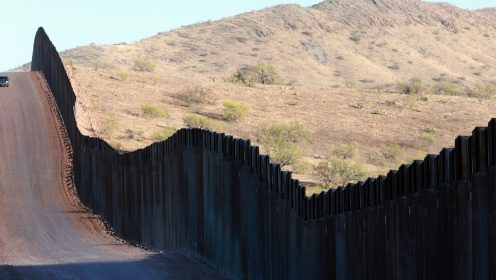by Michael S. Kochin
Walls can work when citizens are united to defend them from their side and united to defend them by whatever violent intervention is required on the other side.

Civilization requires walls and yet cannot be defended merely from behind them. We therefore need whatever we can glean from history and experience about how walls work, when walls work, and what we have to do on our side and on the other side to keep ourselves safe within them.
The Zionist leader Ze’ev Jabotinsky wrote in his celebrated 1923 essay “The Iron Wall” that “Zionist colonization … can proceed and develop only under the protection of a power that is independent of the native population—behind an iron wall, which the native population cannot breach.” But of course, as October 7 reminds us, any wall can be breached, and it is the job of the defenders of civilization not only to prevent breaches but to be ready to mitigate the consequences of any breach. It is certain that breaches will occur and we must sustain defenses on, beyond, and within our walls, as long as our enemies know that they can breach them and value the destruction they can inflict more than the consequences we can impose on them for breaching them.
Sometimes small lessons are easier to learn than large ones. History and policy have effectively divided the Arab population of the geographers’ Palestine west of the Jordan River into three groups. Two million Arabs live in Israel, approximately three million in the West Bank under effective Israeli occupation, and two million in Gaza in a war zone one-sixth the size of Rhode Island. In the current war, they have engaged with the Jewish state and the Jewish population in very different ways.
As recently as 2000, during the Second Intifada, some Israeli Arab citizens engaged in mass violence against Jewish civilians. In this war, one of the few positive developments is that Israeli Arabs have overwhelmingly chosen the side of Israel against her enemies, as rescuers on the horrible day of October 7 itself, as young men serving as soldiers in the Israel Defense Force, as the medical personnel, restaurateurs and bus drivers that have made it possible for Israel to fight for over a year at maximum effort. On the West Bank, where the Israeli Army continues to rule and the Arab towns and villages are interlaced with the so-called settlements, that is to say, Jewish towns and villages, there has been no mass uprising and only scattered, usually individual, acts of terror. It could be a lot worse, and in past outbreaks, it was. In Gaza, fighting continues, and the surviving fighters are sheltered and aided not only by foreign-financed international agencies and NGOs but by the population, which may be weary of war but only because the destruction Hamas effected on October 7 has been visited upon them in stern and multiplied measure.
To return to the question of walls. For Jabotinsky, “the Iron Wall” was mostly a metaphor for British Mandatory and Jewish Zionist intransigence in the face of Arab opposition. For Israel, today, with its 440-mile “separation barrier” from the West Bank, the “Iron Wall” is both metaphor and reinforced concrete reality. Israeli Arabs would have preferred not to be ruled by the Jews, but repression, determination, and ever-increasing opportunity have reconciled them to the benefits and burdens of Israeli citizenship. The West Bank population still probably hopes for complete independence and a Judenrein Judea and Samaria. Yet even the Fatah Party that runs the Palestinian Authority does not see opportunities for the kind of killing, kidnapping, looting, and burning that Hamas seized on October 7—not only because the West Bank is separated by a wall from Israel proper but because the entire territory is effectively occupied by the IDF. With regard to Gaza, October 7 has persuaded the vast majority of Israelis that there can be no safety for Jews anywhere within missile reach of Gaza, much less in border communities, without an indefinitely prolonged presence of the IDF in Gaza itself.
So yes, walls can work. They can work when citizens are united to defend them from their side and united to defend them by whatever violent intervention is required on the other side. As Jabotinsky foresaw in 1923, intransigent defense of civilization will persuade its enemies only to drop hostility for a share in civilization’s benefits only when and insofar as these enemies come to believe that the despotism of the civilizing power is beyond their capacity to break or throw off. The US can have a safer and more secure southern border, but only if Americans want it, and that means not only if Americans finish Trump’s barrier but if Americans are willing to do whatever is necessary in and to Mexico to persuade Mexicans to do their international duties and prevent illegal breaches of their northern border by drug and human trafficking cartels.
None of this will be easy, pleasant, or photogenic, and it will come at vast human cost both to us and to others. But if we Americans want to keep the country we took from our own natives and the civilization we have built in it, we have no alternative but to build walls, keep them up, and guard them ceaselessly from both sides.
Michael S. Kochin
Source: https://amgreatness.com/2024/10/31/of-walls/
No comments:
Post a Comment